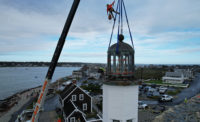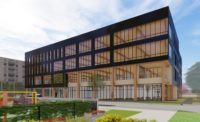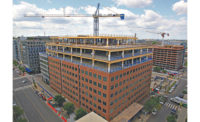NJ Firm Hyper Tracks Building Renovation for Dartmouth, Mass., Vaccine Plant
Facility designed to develop new vaccines for COVID-19 and other infectious diseases

Site work is underway for a vaccine manufacturing facility in a Dartmouth, Mass., business park, with plans for developing new vaccines for COVID-19 and other infectious diseases.
Tonix Pharmaceuticals of Chatham, N.J., is planning a 45,000-sq-ft clinical-scale manufacturing facility to be constructed as an existing building renovation in the New Bedford Business Park in Dartmouth. The facility is expected to be operational in the first half of 2022.
The clinical-stage biopharmaceutical company declined to reveal the cost of the project.
Dean Poillucci, New England regional business unit director for Woburn, Mass.-based IPS Engineering, architect and engineer of record for the project, says Cardinal Group crews are involved with slab cutting and removal to accommodate underground utility services and preparing fittings for the new “Butler building prefabricated warehouse type structure.” The team plans to add a 4,000-sq-ft addition to one corner of the existing estimated 70s era structure. Crews will modify the façade and make interior structural improvements or additions to support the equipment, he says.
"The project is a significant renovation; all that remained of the existing building were the roof and walls," says Bill Held, principal at the Cardinal Group of Woburn, Mass. The Cardinal Group’s New England construction division is taking an integrated project delivery approach “to match the technical expertise and experience required to deliver the project with the quickest delivery schedule possible,” IPS said. It noted “the project is unique as Tonix is a virtual company and this project is their first facility of this type.”
Mitigating tight labor and supply chain challenges
The greatest construction challenge is “the super aggressive schedule, the tight labor market and the high intensity of life sciences projects” Poillucci says. The limited availability of critical supply chain resources to contractors in New England has also created challenges, he notes.
“We started engaging on the construction side way before the design was developed, giving them as much advance notice as possible and letting them know we wanted them to be part of the project; that is absolutely the key piece,” Poillucci says. “For people who come out of the gate cold, and want to start calling contractors, the availability is not there for that type of reaction,” he says
IPS as an integrated engineering, procurement and construction management (EPCM) company, was also “able to stagger the design to meet the long-lead material items and order those way in advance over normal method of delivery,” Poillucci says. This allowed it to “highly mitigate the long lead time issues with equipment and materials.”
GMP vaccine production
The new facility is designed to house Tonix’s Advanced Development Center (ADC) for accelerated research, development and analytical capabilities, as well as the production of clinical trial quality vaccines, including COVID-19, Tonix said. It is expected to be operational in the first half of 2022 and at full capacity, it will employ up to 70 researchers, scientists, manufacturing and technical support staff.
The Biosafety Level 2 ADC lab will include single-use bioreactors and purification suites with equipment for Good Manufacturing Practice (GMP) production of vaccines for clinical trials, IPS said. When fully operational, it will be able to produce sterile vaccines in glass bottles and accommodate “research, development, and supporting analytical capabilities,” it noted.
Seth Lederman, Tonix president and chief executive officer, says the project provides “a competitive advantage, especially in the current COVID-19 environment in which more domestic development and manufacturing capacity is needed.”
Lederman supported opening the plant near Boston because of the pool of life sciences talent there, but opted to locate 60 miles south of the city to avoid traffic congestion and real estate costs.
Mainstay Engineering of Bell, Pa. structural steel design subconsultant for IPS designed a structure that “meets the mechanical process requirements of the facility and architectural requirements,” Poillucci says. Due to the facility type, two key challenges involved “a large amount of coordination with the manufacturing spaces below the structure and assuring that the vertical heights of the building available to the project weren’t compromised due to the stacking of the structure in the existing space,” he says.
Steel reinforcement was required to accommodate heavy equipment at roof penetrations and at the openings of area intake and exhaust plenums, Poillucci adds.




